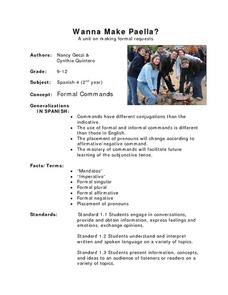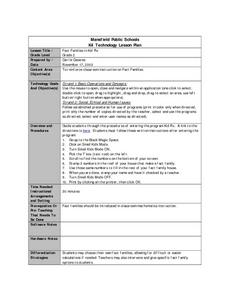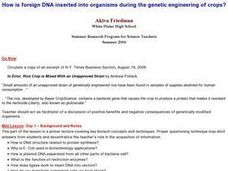Curated OER
Classifying Materials
Students collect data and make observations on how given element samples respond to the field of a magnet and they calculate the density of the samples by finding the mass and volume.
Curated OER
Aluminum Foil Boats
Learners design a boat of aluminum foil and calculate the density of the boat. Washers are added to the boat until it sinks. Students then redesign boat to hold more washers and recalculate the new density.
Curated OER
Swinging
Pupils examine and modify a swinging apparatus. They describe the motion of an object by its position, direction of motion, and speed. Students measure motion using a graph.
Curated OER
Sound Box
Students make simple observations and identify relevant variables, such as frequency and diameter. They then discuss the relationship between variables. The task assesses students' abilities to make simple observations and make...
Curated OER
Reaction Rates
Students work in groups of 4-6 for the experiment/activity part of this exercise. They base their explanation on what they observed. Students observe how substances react chemically in characteristic ways with other substances to form...
Curated OER
Identifying Elements
Students use diffraction glasses to find similarities and differences between observed spectrum of fluorescent light and an incandescent light They work in groups of 4-6 for the experiment/activity part of this exercise.
Curated OER
Dichotomous Key
Eighth graders use a dichotomous key to identify unknown fictitious organisms. They work individually during this exercise. The task is designed to take students approximately 15-25 minutes to complete.
Curated OER
Formation of Wind
Learners correctly sequence the steps leading to the formation of wind, and describe the cause and effect relationships involved in the formation of wind. This task assesses students' abilities to classify, generalize, infer, interpret...
Curated OER
Scale Model of the Solar System
Students work in groups of 4-6 for the experiment/activity part of this exercise. Students know that earth is the third planet from the sun in a system that includes the moon, the sun, eight other planets and their moons, and smaller...
Curated OER
Wet-Dry Bulb Hygrometers: Measuring Relative Humidity and Apparent Temperature
Pupils work in groups of 4 for the activity/activity part of this exercise. They know that clouds are formed by the condensation of water vapor, affect weather and climate. Also that global patterns of atmospheric movement influence...
Curated OER
Investigation Xylem
Middle schoolers investigate how water travels up the stem of vascular plants by using food coloring to stain the xylem of a number of different plants. They know the function of leaves, stems, and root at the end of the experiment.
Curated OER
George and Sam Save for a Present
Third graders develop their algebraic thinking by recognizing a variety of patterns using concrete objects, numbers, tables, and pictures. In this George and Sam Save for a present lesson, 3rd graders communicate their mathematical...
Curated OER
Mimics Survive -- Camouflaged Reptiles
Students examine mimicry as a survival strategy in repiles. They examine examples of the Mexican milksnake and the coralsnake in attempt to distinguish the differences in them. They discuss other species that use mimicry.
Curated OER
Making Formal Requests
Students investigate the concept of making formal requests and examples are included in the lesson for teacher presentation. They practice using the phrases in a variety of situations and then make presentations for others to hear.
Curated OER
Plants Reproduce and Grow in Various Ways
Third graders take a walk around the outside of the school and examine their clothing to see if they picked up any seeds while on their walk. They discuss how seeds travel and how a new plant thus can form. They then observe root...
Curated OER
Meteorology -- Clouds
Fourth graders examine the processes of condensation and evaporation. They identify the three types of clouds and state the weather that is possible with each type of cloud. They ask questions to end the lesson.
Curated OER
Sound
Second graders study how sound is produced by vibrations and is transmitted through matter in all directions. They observe how sounds are produced and identify the ways in which sound travels.
Curated OER
Fact Families in Kid Pix
Second graders study Fact Families in Kid Pix. They use the mouse to open, close and navigate within this application. They assess one click to select, double click to open, drag to highlight, drag and drop, drag to select an area, use...
Curated OER
Four Corners Spelling
Second graders participate in a spelling activity using clapping and rhythmic patterns. In this ongoing spelling instructional activity, 2nd graders practice various spelling words in groups and using rhythms. Students then...
Curated OER
ETHICAL USE OF THE INTERNET
Students investigate the use of the internet and how it should be used by students. The concepts of intellectual property and fair usage are covered. The author of resources is found by them through practice with finding small print...
Curated OER
Careers In Agriscience
Students investigate careers in Agriscience. They participate in various activities to stay engaged in the lesson. Students also research different careers that are available in the field. Then they answer questions about a career of...
Curated OER
How is Foreign DNA Inserted into Organisms During the Genetic Engineering of Crops?
Learners examine the positive benefits and negative consequences of genetically modified organisms following a lecture covering key biotech concepts and techniques. Students then conduct and experiment comparing the travel rate of...
Curated OER
About The Author Lesson 4
Fourth graders engage in a lesson plan that continues the creation of a specialized Microsoft Word document. They practice creating art using Wordart and inserting images into the document with a paragraph attached. One of the main...
Curated OER
Heritage: What Would You Take?
Fifth graders explore their own definitions of valuable, and decide what they would choose to take with them if they could only take one item. They define the reasons their items are valuable to them.























